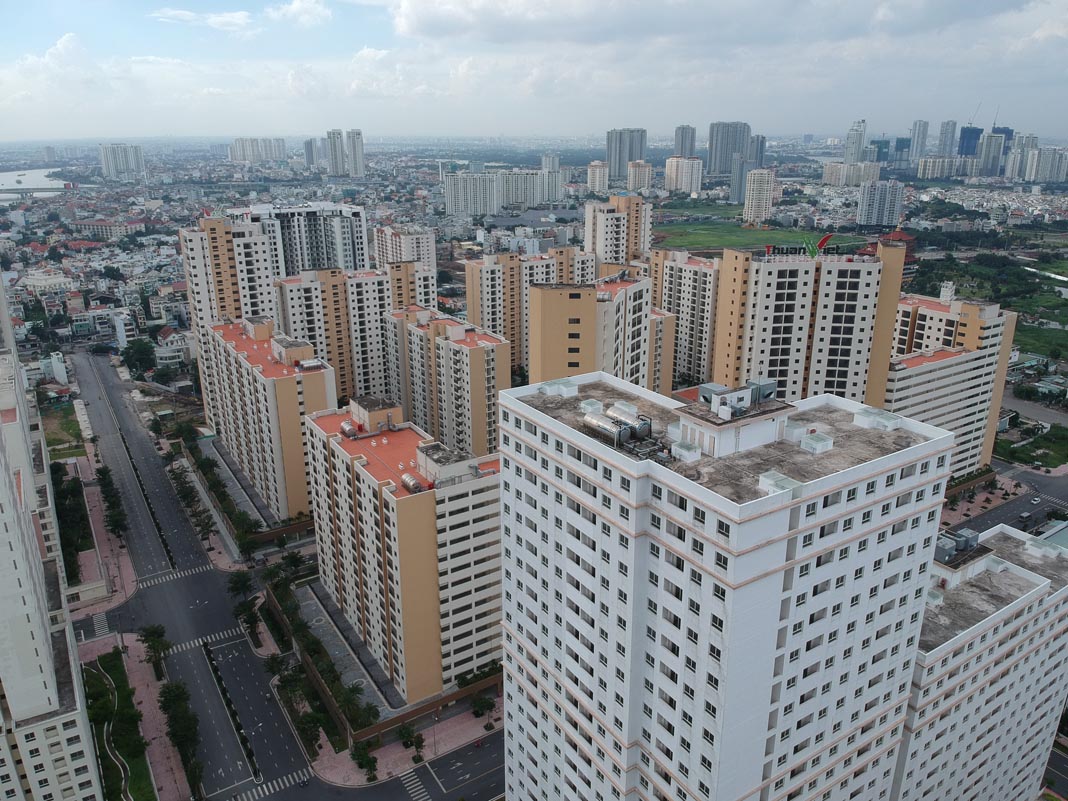Optimism rose among urban dwellers early this year as several medium and large-sized businesses revealed plans to build affordable housing projects. However, given a year-end market contraction, the initiative only serves as a starting point for a broader movement in the industry, aiming to seek improvements in the country’s legal framework.
A chicken-and-egg situation
According to data from the HCMC Real Estate Association (HoREA), home prices in Vietnam are 20 times higher than the income of an average worker. Meanwhile, affordable housing accounted for a mere 1% of the total supply in 2020, dropped to zero in 2021 and showed no signs of improving in 2022.
Speaking at the National Assembly in early November, Minister of Construction Nguyen Thanh Nghi said housing development has lagged behind expectations despite being one of the country’s top priorities, citing that only 7.8 out of 12.5 million square meters of homes have been provided to residents. Social housing made up 36% of the total demand nationwide.
Many obstacles remain in the eyes of housing developers, particularly with the overlapping policies between the Law on Housing and other regulations on incentives, pricing and a 20% minimum land fund requirement for social housing, among others. More importantly, lacking the determination to cut red tape in construction-related administrative procedures has significantly hampered the expansion of housing projects.
During a recent meeting with the Government, Le Huu Nghia, general director of Le Thanh Construction – Trading Company Limited, said that the country’s legal framework for the development of social housing seemingly mirrored a chicken-and-egg situation. For example, after submitting proposals to the HCMC Department of Planning and Investment, the firm faced hurdles in terms of a policy constraint that only permits the authorities’ approval of projects that align with the local planning.
“I believe that there is certainly no project in Vietnam that is entirely in accordance with the plan,” said Nghia. In particular, the HCMC overall plan now seems obsolete as it was issued 10 years ago. Meanwhile, the housing projects could not seek incentives in accordance with the regulations of Government Decree No. 100. Although companies suggest modifications in the legal framework, their efforts are hampered given the authorities’ refusal to provide permission. In this regard, “it is hard to say which of the two things existed first”, added Nghia.
Previously, Ngo Quang Phuc, general director of Phu Dong Group, stated that real estate enterprises had been put in peril due to tight credit, rising wages, lack of available land, and legal bottlenecks. Given the arduous challenges, it is difficult for investors to lower the pricing of home projects.
Phuc underlined the importance of reducing administrative processes and speeding up the pace of the projects, including social homes and housing for workers.
Early this year, Truong Thanh Furniture Corporation, Hung Thinh Corporation and Dong Tam Group decided to join hands in developing affordable housing. Still, the firms have just been treading water in the initiative.
According to a representative of Hung Thinh Corporation, after receiving the project proposal, the HCMC People’s Committee delivered it to relevant departments and agencies, then, the authorities sought feedback several times, but the proposal has yet to be approved. Thus, the firm was compelled to submit the proposal to ministerial bodies hoping to get the nod soon.
Given their capabilities and strong motivation, many companies intend to collaborate on affordable housing projects. However, their promising initiatives have been delivered as suggestions and recommendations rather than actions. During Minister Nguyen Thanh Nghi’s Q&A session of the National Assembly, no viable solutions were provided. The growing gap between housing demand and policy conditions that favored corporate capabilities seems unbridgeable soon.
Challenges in capital mobilization
The three top priorities for enterprises in creating affordable and social housing are the legal framework, land and bank loans.
From 2016 to 2020, individuals and investors were offered loans with interest rate incentives by the Vietnam Bank for Social Policies (VBSP) and certain commercial banks authorized by the Government.
According to a report from the VBSP, some VND3,163 billion out of VND9,000 billion were granted as part of a financial package of individual capital mobilization for renting, constructing and renovating social housing projects.
However, the four commercial banks authorized by the Government did not receive an interest-rate compensation package from issuing soft loans for social housing. Consequently, there were no investors in social housing and home-for-workers projects that received the incentives.
In terms of commercial housing, Le Hoang Chau, chairman of HoREA, said there have been signs of a credit imbalance regarding the rise of high-end home projects in recent years.
In HCMC, commercial housing projects between January and September required an investment of VND103,780 billion, a 6.5-fold increase compared to the same period last year. As a result, when high-end home projects accounted for roughly 80.2% of the total supply, the funds needed for the segment might reach VND82,231 billion, or 80.2% of the total.
Given bank loans of around 60-70% of the funds, it would indicate that approximately VND49,938-58,261 billion would be drawn to the luxury segment. Consequently, the credit imbalance occurs as luxury housing prices are 10 times higher than affordable home prices.
According to the Ministry of Construction, it would cost around VND1,130 trillion to create one million social homes and housing for workers by 2030.
Thus, the ministry suggested that relevant departments, agencies, and municipalities arrange funding for the housing project. Social housing for low-income residents accounts for around 60% of the overall investment, or approximately VND850 trillion. The rest is allocated to worker home projects, which need some VND280 trillion.

Furthermore, raising capital for the housing project would need a joint effort from multi-level agencies. The Ministry of Construction proposed that the State Bank of Vietnam collaborate closely with relevant ministries in terms of adding public midterm investment for 2021-2025 and 2026-2030, as well as speeding up policies to provide incentives in the commercial lending interest of 2% for the housing projects.
During the November 3 Q&A session, Minister Nguyen Thanh Nghi emphasized the significance of developing a better legal framework, restructuring credit in the real estate business, prioritizing bank loans for social and affordable housing projects and removing obstacles to under-construction buildings.
In addition to the efforts of the Government, the cooperation of leading enterprises is one of the key factors driving progress in social house construction. If the Government removes the major impediments in capital, land fund and regulations, among others, engaging in housing projects will be more enticing to corporates seeking to expand their investments.
However, given the market’s bleak outlook, the ambitious endeavor remains challenging. As many firms struggle with finance and liquidity, creating affordable houses may be in for a long wait for regulatory improvements.









